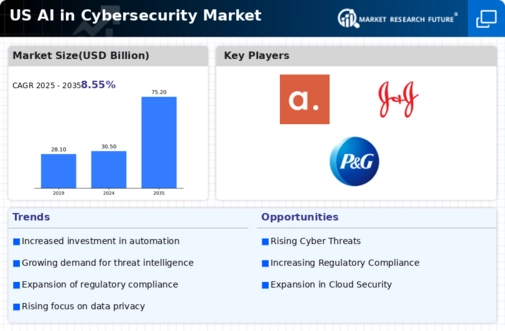The ai in-cybersecurity market is characterized by a rapidly evolving competitive landscape, driven by increasing cyber threats and the growing need for advanced security solutions. Major players such as CrowdStrike (US), Palo Alto Networks (US), and IBM (US) are at the forefront, each adopting distinct strategies to enhance their market positioning. CrowdStrike (US) focuses on innovation through its cloud-native platform, emphasizing real-time threat intelligence and automated response capabilities. Meanwhile, Palo Alto Networks (US) is expanding its portfolio through strategic acquisitions, enhancing its AI-driven security offerings. IBM (US) is leveraging its extensive research capabilities to integrate AI into its cybersecurity solutions, aiming to provide comprehensive protection across various sectors. Collectively, these strategies contribute to a competitive environment that prioritizes technological advancement and customer-centric solutions.
Key business tactics within the ai in-cybersecurity market include localized service offerings and supply chain optimization, which are essential for addressing the diverse needs of clients across different regions. The market structure appears moderately fragmented, with a mix of established players and emerging startups. This fragmentation allows for a dynamic competitive atmosphere, where innovation and strategic partnerships play a crucial role in shaping market dynamics.
In October 2025, CrowdStrike (US) announced a significant partnership with a leading cloud service provider to enhance its threat detection capabilities. This collaboration is expected to bolster CrowdStrike's position in the market by integrating its AI-driven solutions with the cloud provider's infrastructure, thereby improving scalability and response times for clients. Such strategic alliances are indicative of a broader trend towards collaborative innovation in the cybersecurity space.
In September 2025, Palo Alto Networks (US) completed the acquisition of a prominent AI startup specializing in machine learning algorithms for threat detection. This acquisition is likely to enhance Palo Alto's existing capabilities, allowing for more sophisticated threat analysis and response mechanisms. The integration of advanced AI technologies is anticipated to strengthen its competitive edge, particularly in sectors with high-security demands.
In August 2025, IBM (US) launched a new AI-powered cybersecurity platform aimed at small to medium-sized enterprises (SMEs). This initiative reflects IBM's commitment to democratizing access to advanced cybersecurity solutions, potentially expanding its market reach. By tailoring its offerings to SMEs, IBM is likely to capture a significant share of this underserved segment, further solidifying its market presence.
As of November 2025, current trends in the ai in-cybersecurity market include a heightened focus on digital transformation, sustainability, and the integration of AI technologies. Strategic alliances are increasingly shaping the competitive landscape, enabling companies to leverage complementary strengths. Looking ahead, competitive differentiation is expected to evolve, with a shift from price-based competition towards innovation, technological advancement, and supply chain reliability. This transition underscores the importance of agility and responsiveness in a market defined by rapid technological change.

















Leave a Comment